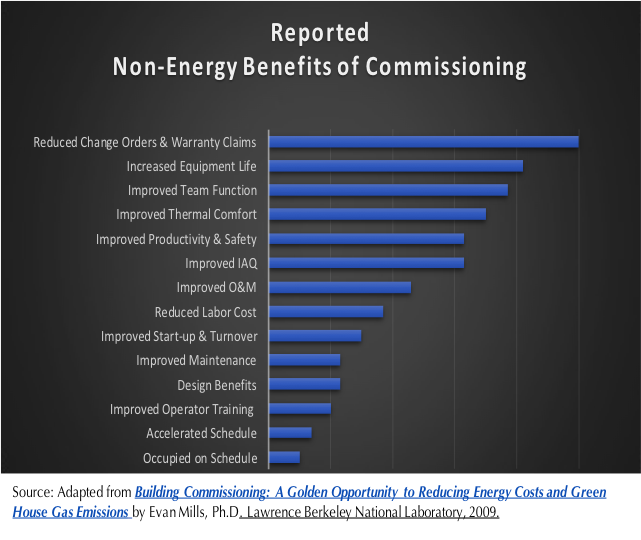
The Commissioning Value Proposition: Building the Framework
June 6, 2019
By Sonya M. Pouncy, CEM, CMVP, LEED-AP. Sonya is a senior engineering consultant with Energy Sciences. The firm helps clients meet energy challenges with practical solutions that reduce waste and increase net operating income.
When most people think of commissioning, they tend to think of the function testing that occurs after building systems are installed. But, the most successful commissioning efforts recognize that commissioning begins long before equipment arrives onsite. Even so, facility managers are sometimes challenged in persuading building owners to follow a more thorough commissioning process. In part, this is because many building construction codes only require the final portion of the process to be performed, like the testing and balancing of HVAC distribution systems and the function testing of lighting controls. Also, it’s easy to forget that construction codes are minimum performance requirements, and that in order to achieve long-term, high-performance and value, often we need to exceed them.
 If building project decision-makers do not understand the benefits, value and risks associated with commissioning, they will not allocate resources to support it. Facility managers can better frame the value proposition of commissioning by helping the leadership team to appreciate the numerous ways that commissioning adds value beyond energy and cost savings.
If building project decision-makers do not understand the benefits, value and risks associated with commissioning, they will not allocate resources to support it. Facility managers can better frame the value proposition of commissioning by helping the leadership team to appreciate the numerous ways that commissioning adds value beyond energy and cost savings.
In a Lawrence Berkley National Laboratory study of 643 buildings (82 of which were new), building owners self-reported non-energy benefits of commissioning that included improved indoor air quality and comfort, smoother project delivery, longer equipment life and improved operations and maintenance (O&M) staff preparedness and productivity.
Facility managers can further advance their case by providing a good understanding of building project delivery and performance goals in proper context—that is, in terms of dollars. Things like reduced warranty claims, O&M team readiness, and occupant satisfaction can be monetized from the perspective of the building owner and the intended occupants. It’s important to remember that while owners are typically the ones paying the upfront construction costs, most buildings are not entirely owner-occupied; so, in general, rent-paying tenants ultimately pay for construction projects. Because these occupants have choices of where to spend their rent dollars, building owners cannot afford to overlook their building performance requirements. The combined criteria of owners and occupants should form building performance goals and targets which should, in turn, be factored into the building quality assurance plan. Assigning dollar values to targets—and to the risks of not meeting them—helps quantify the rationale for commissioning.
To further justify the effort, it helps to start with the end in mind. Let’s say you’re a developer constructing a building. If, for example, the building is being developed for a 50-year life, what is at the end of that 50-year period? If the intention is to sell the building, for how much money do you want to be able to sell it and in what condition does it need to be in order to garner that price? Or, if you intend to still be leasing the space in 50 years, what services and amenities will tenants want in 50 years and can your building be easily maintained or upgraded to provide them? Answering these questions will help you define the level of quality and robustness that will need to be incorporated into your building. And, in order to protect the dollars invested, you’ll want to be assured that the delivered project provides the defined levels of quality, energy efficiency, resiliency, and maintainability. In the construction industry, the best way we know to achieve this assurance is through commissioning.
Admittedly, not every construction project needs to have the rigor of full commissioning; but most projects can benefit from going beyond the code minimum requirements of mere function testing. In all cases, it is recommended that a cost-benefit analysis be performed as it will make it easier to see when and for which systems commissioning efforts should go beyond the basics. The Lawrence Berkley National Laboratory study cited earlier found that, on average, new building projects that are commissioned avoid $0.18/ft2in first costs and achieve energy savings of 13% compared to projects that are not commissioned. Retro/recommissioning projects achieved $0.29/ft2in avoided costs, energy savings of 16% and paid for themselves in about 13 months. Your project might do even better than that. Contact us today at [email protected] to discuss the level of commissioning that’s best for your next construction project.





